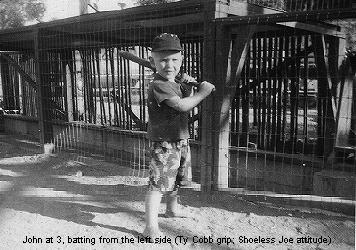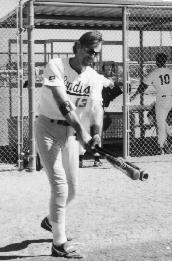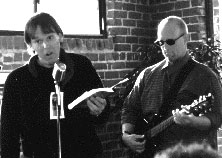 |
||
| Home | Blog | Books | Bio | Interviews | Music | Essays | FAQ | Appearances | Contact | ||
| Fenway Fever | The Desperado Who Stole Baseball | The Boy Who Saved Baseball | Under the Baseball Moon | Choosing Up Sides | Over the Wall | ||
John H. Ritter's Biography
Novelist John H. Ritter (born October 31, 1951, in San Pedro, California) grew up in the summer-dry hills east of San Diego. "I grew up in a baseball family," says John. "But we were also a family of musicians and mathematicians, house painters and poets. My dad was a sports writer in Ashtabula, Ohio, who moved the family out west, just before I was born, to become Sports Editor for The San Diego Union." Growing up in a sparse, mountainous region also helped stretch John's imagination. "Out in that country," he says, "there was a real sense of the spirits who walked the land in the centuries before. And being so cut off from other kids, I roamed the hills a lot, following hawks and eagles, climbing boulders, sitting in Indian caves. Rattlesnakes never bothered us much. But I felt the spirits everywhere. I think my mom, who was part Blackfoot Indian, had a lot to do with that." When John was only four, however, his mother died of breast cancer, leaving his father to raise four small children on his own. John still recalls his mother and her songs. "One thing I remember about my mom is that she sang to us constantly, making up a song for each of her four children that fit our personalities perfectly. So from her, I got a sense of how to capture a person's spirit in a lyrical phrase." Over time, his musical interests continued to grow and in high school, the social commentary of folksinger Bob Dylan inspired him to write his own songs, hoping to pursue a musical career. He was, however, a “wild student,” he admits to English professor Chris Crowe in an interview for The ALAN Review, and was torn between his love of baseball and writing, calling himself both “a high achiever and a rabble rouser,” noting, for example, that in 1969 he was voted Senior Class President and the Senior Class Clown. Teachers did, however, recognize his writing talent, although his work was so often read out loud in class that he also admits to growing complacent and somewhat lazy about having to improve his skills. At the University of California, San Diego, John studied communications while playing for the UCSD baseball team, In 1994, after publishing several short stories, John received the Judy Blume Award and a cash grant from the Society of Children’s Book Writers and Illustrators (SCBWI) for a novel in progress. In 1996, he submitted his manuscript through the Curtis Brown Agency to Philomel Books where it became the first book-length acquisition of junior editor, Michael Green. Since then, Green has risen to become Editorial Director and Publisher of Philomel Books and has edited all six of John’s novels. In 1999, John’s first novel, Choosing Up Sides, won the International Reading Association Children’s Book Award for Older Readers and was designated an American Library Association Best Book for Young Adults. The hard-hitting work of historical fiction, set in Southern Ohio, was praised by Kirkus Reviews as, “No ordinary baseball book, this is a rare first novel.” Since then, John has published five more award-winning books and numerous short stories. In 2004, he received the Paterson Prize for Children’s Literature for his third novel, The Boy Who Saved Baseball. Cited in People Magazine as a book to read, “Now that the youngsters have read Harry Potter...”, The Boy Who Saved Baseball also garnered a rave review in Publishers Weekly, which called the book’s prose “Enthralling...at times stunning,” and that, "Ritter delivers a baseball tale of legendary dimension.” According to Vicki Sherbert, writing in The ALAN Review, “Ritter uses the game of baseball, the glory of music, and the power of the written word to illustrate how young people can overcome everyday, and not-so-everyday, challenges. Each book goes beyond the story of the game, beyond the story of the problem, right to the heart of Ritter's message: What is really valuable in life?” Literary scholar and essayist, Patty Campbell, also notes that, “Another aspect of John H. Ritter’s writing that merits high praise is the variety and inventiveness of his language. Richly evocative metaphors gather layers of meaning as the stories unfold, and the verbal style of each novel is neatly crafted to the place and time of its setting. Under the Baseball Moon dances to a hip hop beachtown beat; Over the Wall wisecracks with a California kid’s take on New York; The Boy Who Saved Baseball draws on both Spanish and English to make up zingy new expressions, and Choosing Up Sides savors the naiveté of the historic Appalachian dialect of southern Ohio. His settings, too, are vividly distinct and vary from the Hispanic/Anglo blend of his own Southern California hill communities to the “small town” neighborhoods of present day New York; from the eclectic oceanfront culture of the Pacific beach towns to the church-centered villages on the banks of the Ohio River during Prohibition.” John’s fifth novel, The Desperado Who Stole Baseball, was a 2009 Jr. Library Guild selection and takes an historical look at the roots of racism in the Major Leagues. Set in the Wild West of the 1880s and written in the manner of a tall tale, Desperado is a prequel to The Boy Who Saved Baseball. And coming soon (April 12, 2012) is John’s sixth novel, Fenway Fever, also a Junior Library Guild selection and a book his publisher describes as “another magical novel that celebrates teamwork—and the innate power to heal that even the least among us is born with.” New York Times bestselling author Peter Abrahams called Fenway Fever, "A funny, exciting, original, and heartwarming novel." “In all of these wonderful novels,” writes Patty Campbell, “John H. Ritter steps up to the plate and hits a home run for teen reading with books that are fun to read, fun to discuss, and important in the difficult process of growing up to be an ethical human being.” For deeper biographical information on John H. Ritter, please see the Wikipedia entry on his life and work. |
||
|
Home | Blog | Books | Bio | Interviews | Music | Essays | FAQ | Appearances | Contact Fenway Fever | The Desperado Who Stole Baseball | The Boy Who Saved Baseball | Under the Baseball Moon | Choosing Up Sides | Over the Wall |
||


 all-the-while continuing to write Dylan-style songs. But by his sophomore year, he recalls, “I was anxious to get on with my life. And for the vision I had in mind, college didn’t have much to offer me. I knew I had to walk the streets, touch life, embrace life, gain experience.” So like his literary heroes before him, i.e., Dylan, Jack Kerouac, and Mark Twain, John quit school, taking a job as a painter’s apprentice, and set about traveling the country. He learned to live so cheaply that he could earn enough in three or four months to allow him to travel and write for the rest of the year. He did that for several years, until he married his wife, Cheryl, whom he had met in college, and they had a baby daughter. With a family to support, John needed to work nine months a year, painting houses, but the rest of his time went into writing, an artistic lifestyle he later spotlighted in his song-laden socio-political novel, Under the Baseball Moon.
all-the-while continuing to write Dylan-style songs. But by his sophomore year, he recalls, “I was anxious to get on with my life. And for the vision I had in mind, college didn’t have much to offer me. I knew I had to walk the streets, touch life, embrace life, gain experience.” So like his literary heroes before him, i.e., Dylan, Jack Kerouac, and Mark Twain, John quit school, taking a job as a painter’s apprentice, and set about traveling the country. He learned to live so cheaply that he could earn enough in three or four months to allow him to travel and write for the rest of the year. He did that for several years, until he married his wife, Cheryl, whom he had met in college, and they had a baby daughter. With a family to support, John needed to work nine months a year, painting houses, but the rest of his time went into writing, an artistic lifestyle he later spotlighted in his song-laden socio-political novel, Under the Baseball Moon.